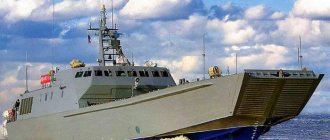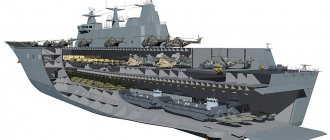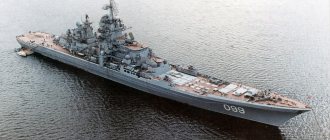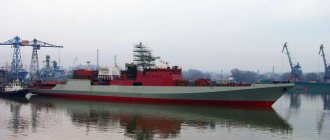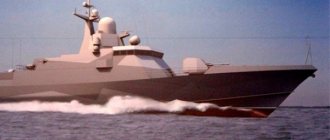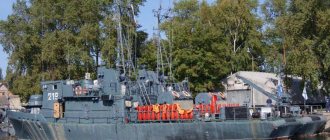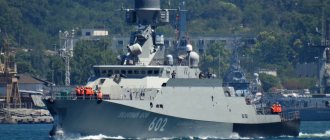The Project 11711 large landing ship (LHDK) “Petr Morgunov”, which arrived at the Northern Fleet, will be sent to Arctic routes. It is planned to make it the most important element in supporting the military group on the islands and coast, as well as along the Northern Sea Route. The design of the unique BDK allows it to land marines from the sea and air, unload equipment and cargo directly onto the shore. To do this, the ship actually rolls out there and opens special ramp hatches in the bow. Another task of the newest BDK in the Arctic will be the delivery of fuel, lubricants and food to remote sites where there are no berths.
Along the Northern Sea Route
A fundamental decision was made to make the Project 11711 large landing ship “Petr Morgunov” the basis of the Arctic group of ships of the Northern Fleet, sources in the Ministry of Defense told Izvestia. In terms of its technical characteristics, the BDK is seriously superior to older ships of this type. With its help, it will be possible to quickly deploy operational units of troops along the entire Northern Sea Route (NSR). For example, transfer anti-aircraft missile systems, radars or coastal missile systems. And after completing the tasks, promptly pick them up.
“Agile” pace: the newest Russian corvette is heading to the northeast
By the end of next year, the second ship of Project 20385 will be completed and sent to protect Kamchatka
Also, according to the publication’s interlocutors, another task of the BDK will be to ensure the functioning of facilities along the NSR. "Petr Morgunov" will be able to deliver various cargoes to remote bases and populated areas. And if necessary, it will become the base for a rescue operation.
Last week, with the participation of Admiral Alexander Moiseev, a solemn ceremony was held for the acceptance of a combat unit into the Northern Fleet - the Red Banner Kola Flotilla of heterogeneous forces based in Severomorsk.
According to the Commander-in-Chief of the Navy, Admiral Nikolai Evmenov, the Pyotr Morgunov is even more advanced in a number of characteristics than the lead ship of this project, the Ivan Gren. It has been in operation in northern latitudes for two years and has already proven its reliability and efficiency.
“The new ship will have two main tasks - supplying the Arctic group and conducting landing operations,” military historian Dmitry Boltenkov told Izvestia. “And for this he has a big advantage compared to previous projects - his own helicopters and a closed hangar for them. These vehicles can be used to transport marines and transport small cargo by air. In addition, the Petr Morgunov is more spacious and can deliver more soldiers, equipment and materials in one flight.
Captain 1st rank appreciated the long voyage of Russian landing ships
Photos of the ships appeared on social networks. It is reported that a group of six large landing ships of the Northern and Baltic fleets (Petr Morgunov, Olenegorsky Miner, Georgiy Pobedonosets, Minsk, Korolev, Kaliningrad) is heading to the North Sea.
As the head of the joint operations department of the Swedish armed forces, Lieutenant General Michael Claesson, reported, the Russian large landing craft are heavily loaded, and their destination is unknown to anyone. There are already suggestions that Russian ships are heading to the Black Sea region, where, of course, according to the Europeans, they will certainly threaten Ukraine.
Where these ships are actually headed and what kind of cargo may be on board - military expert Captain 1st Rank in the reserve Vladimir Gundarov told MK about this.
“There is not enough information yet to definitively answer such questions,” he explained. — It is reported that the ships have now entered the North Sea. Where they will go next from there - either across the English Channel to the south, or around the Scandinavian Peninsula to the north - is still unclear. As soon as we find out about this, the intent of the operation will become clear. The only fact remains is that this in itself is a unique operation, non-standard and uncharacteristic of the usual situation in the North Sea and in the region as a whole.
According to the expert, if we assume that the large landing craft will go south across the English Channel, for example to the Syrian port of Tartus, where our fleet has a base, then the ships will not be able to reach it without refueling. To refuel six large landing ships, you need to have at least two more tankers somewhere along the route. But there is no talk about them. This means that talking about the southern direction is debatable.
“For now, we can only say one thing,” Gundarov is sure, “some very serious transfer of forces and means is underway.” In addition, observers note that the large landing craft are fully loaded - their waterlines are below the water level. What could this mean? About the fact that some kind of weapons are being transferred by the shortest route - and this is the shortest route. Moreover, these are not tanks, and certainly not personnel. For example, I do not rule out that we are talking about missile weapons.
According to Gundarov, in light of Russia's latest negotiations with the United States and NATO, this may serve as confirmation that Russia can back up its proposals for security guarantees with action if they are rejected by the West.
“It is quite likely,” the expert believes, “that very soon we will be able to see Russian missile systems in some area, which is what NATO members are so afraid of.” At the same time, Russia is demonstrating that it is capable of transporting large forces not only by land and air, but also by sea.
The Arctic in Demand
The tasks of transport supply to the northern units of the Armed Forces have increased significantly in recent years. Both aircraft and ships are used to provide them.
They will sail into the past: by the end of the decade the Navy will be radically renewed
By 2030, there will be no Soviet-built ships left in the group of strategic missile submarines
From January 1, 2022, the Northern Fleet became an independent military district, along with the Eastern, Western, Central and Southern. This demonstrated increased interest at the state level in the Arctic, which has been declared a strategically important macro-region. Not only are there huge reserves of minerals here, but there is also an important transport artery - the Northern Sea Route.
Over the course of several years, new military and border strongholds have been deployed on large islands along the country’s Arctic coast and the Northern Sea Route route. Modern facilities have been built to allow year-round service in comfortable conditions. Air defense units equipped with S-300 and S-400 systems were deployed on Novaya Zemlya and Yakutia. The smaller islands are home to the Pantsir anti-aircraft missile systems and the Bal and Bastion coastal missile systems. A chain of radar stations for air and sea surveillance has been restored along the entire NSR route.
The network of northern airfields is also expanding. On Novaya Zemlya, a squadron of MiG-31BM fighter-interceptors has already taken up combat duty. Their aviation group has been deployed since the end of last year in Anadyr on the Chukotka Peninsula. Since 2022, flights to forward strategic bomber bases have resumed.
Construction of large landing ships of Project 11711
The first landing ship of Project 11711, Ivan Gren, was laid down only in 2004. The first ship of the series was named in honor of the Soviet vice-admiral and scientist Ivan Gren. Although serious changes were made to the construction project three times even at the design stage, during the years of construction, which stretched for almost 14 years, the designers made more than 20 changes.
Project 11711 fully experienced the consequences of the economic crisis in Russia. The project owner and the contractor could not come to an agreed solution for a long time. The main problem was insufficient funding for the project. Although the necessary money for the next stage of work was often allocated in full, the effects of inflation significantly reduced these amounts.
An interesting situation is when, without solving all the problems associated with the construction of the first ship, construction of the second ship in this series began in 2010. Most likely this was due to the need to “master” the additional funds allocated by the budget for this project as quickly as possible. The designers were well aware that in the 6 years that had passed since the start of construction of the first ship of the series, new technologies had appeared, and the first BDK Ivan Gren would not become a model of perfection and the embodiment of modern technical solutions. As time has shown, the designers were right. Project 11711 was decided to be closed after the completion of construction of the second ship in the series.
In 2012, the large landing ship Ivan Gren was launched. After this event, 2 years were allotted for its testing and modification. Major problems regarding the modification of the ship occurred due to the unpreparedness of the Russian military industry to supply the ship with the necessary weapons on time. Other enterprises did not lag behind the military industry, which also did not keep up with the production of the necessary components and assemblies necessary to complete the construction of the first ship of Project 11711.
Although the Ivan Gren ship was supposed to be ready at the end of 2013, it made its first full-fledged trip to sea only in the summer of 2016.
Changes in the design of the ship "Ivan Gren" and its cargo capacity
Since the first ship of Project 11711 was subjected several times to adjustments in terms of armament, changes in performance characteristics and other characteristics, the deadline for its final readiness was postponed several times. Initially, the ship was planned to be equipped with the following weapons:
- Artillery system A-190M 100 mm caliber;
- Two anti-aircraft missile and artillery systems "Palash", which, although they were created in the early 1990s, are still quite rare weapons;
- Two Grad-M multiple launch rocket systems of 122 mm caliber. This system was made on the basis of the 9K51 "Grad" and was designed specifically for fire support for landing troops.
As a result of problems with financing the project, this weapon system had to be abandoned. The new weapons of the Ivan Gren ship consist of the following systems:
- The bow now houses an AK-630M-2 30mm artillery mount;
- At the stern there are two AK-630M artillery mounts, which are combined with the 5P-10-03 “Laska” fire control system, which has proven itself to be excellent at this time;
- Two large-caliber machine guns MPTU "Sting" of 14.5 mm caliber;
- Portable MANPADS.
As can be seen from the last list, the original, quite powerful weapons were replaced with lighter ones, which significantly reduced the combat power of the ship.
As for the carrying capacity of the Ivan Gren ship, the ship can take on board up to 1,500 tons of cargo. This is up to 380 landing troops in full combat gear. In addition to landing troops, the landing ship can carry 13 battle tanks or 36 infantry fighting vehicles.
As a power plant, the large landing ship “Ivan Gren” is equipped with two powerful DRRA-3700 diesel engines with a SUTN-10060 turbocharging system. Each of the power units is capable of developing power up to 5,200 l/s. Each engine room has two powerful diesel generators that supply the ship's electrical needs both in standby mode and in combat mode.
What is the ship "Ivan Gren"
The large landing ship "Ivan Gren" has the following design:
- The ship itself has two decks and two shafts;
- The engine room is located at the stern, there is a forecastle and a poop deck;
- The ship has two superstructures and a huge landing hold that runs from the stern to the bow of the ship. This hold houses armored vehicles;
- The ship's hull and its two superstructures are made of steel;
- Since this ship is designed for long patrols with a large number of personnel on board, the cabins for paratroopers are very comfortable. There is even a gym on board;
- There is a special ventilation system in the compartment for armored vehicles. It maintains a comfortable temperature for starting the engines of the armored vehicles on board;
- Although in the aft superstructure of the Ivan Gren ship there is a hangar designed to accommodate one helicopter, when using a special retractable platform, two helicopters can be placed there;
- The ship's displacement is 6,000 tons;
- The length of the ship is 120 meters, width – 16.5 m, draft – 5 m;
- The ship's crew consists of 100 people.
At the same time, the ship can make long voyages, since its autonomy is 30 days. To detect surface and air targets, the MP-352 Positive radar is used.
Design features of the large landing craft "Ivan Gren"
The ship "Ivan Gren" was laid down in December 2004 at a shipyard in the city of Kaliningrad. When construction began, it was assigned the number 01301.
Project 11711 was developed at OJSC Nevskoe Design Bureau. This project replaced projects 775 and 1171, which were developed before it. By the way, large landing ships of these projects, which were produced in the USSR from 1964 to 1975 (BDK Project 1171) and from 1974 to 1991 (BDK Project 775), are still in service with the Russian Navy.
Project 11711 ships are designed for the following actions:
- Landing on the coast;
- Urgent transfer of military cargo;
- Participation in peacekeeping operations;
- Patrolling the territory with the subsequent release of troops in places where the need arises.
In addition, the ship can take part in the capture of violators of the territorial waters of the Russian Federation.
Since large landing ships, in addition to landing personnel, are capable of landing military equipment, the ship "Ivan Gren" uses the following methods for this:
- Directly to a shore not equipped for landing;
- Disembarkation;
- Landing using a specially equipped KA-29 helicopter.
To unload equipment, a stern ramp or a special bow landing device is used.
An interesting method of disembarkation is disembarkation using a system of engineered pontoons, from which a bridge is assembled from the ship to the shore. Although this method has long been used abroad, it is being used for the first time in Russia. Many skeptics doubt that a lightweight pontoon bridge can withstand heavy armored vehicles.
Also, for the first time on domestic ships of this type, a system for transporting 20-ton sea containers on the upper deck was used. Using a crane beam, these containers can be unloaded both onto the quay wall and onto other ships.


